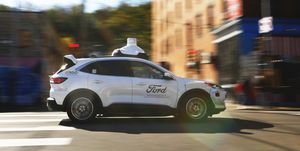Autonomous tech developer Plus has recently completed a real-world demonstration of its Level 4 autonomous truck technology on a traffic-filled highway. The company tested the truck without a driver behind the wheel, and also without any other remote operator who could take control of the truck if needed. The test took place on the Wufengshan highway in the business hub of the Yangtze Delta region, with Plus being the first company to be granted a special permit to test Level 4 vehicles in the country.
Level 4, of course, is defined as possessing automated driving features that can drive the vehicle under limited conditions, and will operate only when all of those conditions are met. In practice, the difference between Level 4 and Level 5 is that the latter can operate everywhere and under all conditions, but what they have in common is that they will not require a driver to intervene. The difference between the two largely boils down to the distinction that Level 4 is geofenced, meaning it is functional only in a certain area or on certain roads, whereas Level 5 will operate anywhere and at any time.
“The driverless demo highlights the ability of our Level 4 autonomous driving technology to enable driverless highway operations in a semi truck,” said Shawn Kerrigan, COO and Co-founder of Plus. “The demo shows the safety, maturity, and functionality of our technology, and we are excited to continue to work closely with our suppliers, fleet customers, and OEM partners to further develop, test, and refine a driverless product for commercial deployment.”
The most frequently-cited real-world example of Level 4 vehicles are driverless taxis that can operate in a certain area of the city, and completely without a driver. Level 4 robotaxis are currently being tested by a number of developers in several cities around the globe, and will be seen at the upcoming Beijing Winter Games, among other venues. But when it comes to commercial vehicles, Level 4 promises truck routes between warehouses that can be completed without a driver behind the wheel. At least in theory.
Plus plans to roll out its Level 4 tech on a commercial basis in 2022 in what it says will be “a dedicated environment,” but doesn’t mention the scale of such an environment. In practice it could be rather small, such as trucks moving between warehouses in a single site, without setting foot on public roads. At the outer edges of Level 4 operation, this could mean a route on public roads that’s several hundred miles in length, or until the truck runs out of whichever fuel it uses.
The biggest question when it comes to Level 4 autonomy in the U.S., of course, is just which jurisdictions will permit it, and which ones will not. This concerns trucks even more than passenger cars, as a significant percentage of truck traffic is interstate in nature, and is arguably also where it makes the most sense. But without a federal framework for autonomous vehicles in place, manufacturers have indicated that they are very averse to introducing Level 3 and Level 4 systems, some of which are already on the market elsewhere, including Japan.
It doesn’t feel like it was that long ago that we went for a ride in a Level 2 semi truck prototype, when Freightliner unveiled the Inspiration prototype semi truck at the Hoover Dam in May of 2015. But it’s notable that in the six years since, autonomous tech of any level has not really become commonplace in trucks on any meaningful scale in the U.S., despite a great amount of progress having been made on a technical level.
Will Level 4 robotaxis become commonplace before 2025 on a meaningful scale, or is this tech still further out? Let us know in the comments below.
Source: Read Full Article



